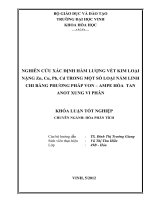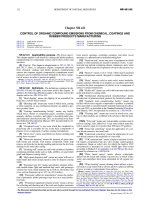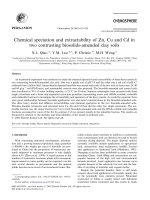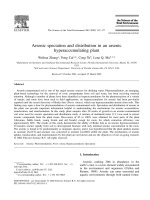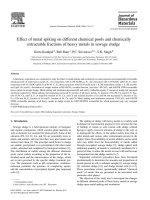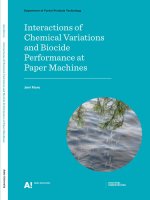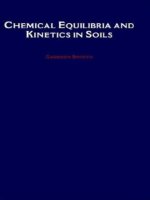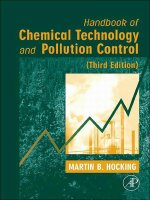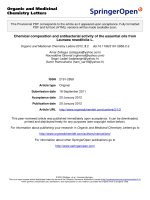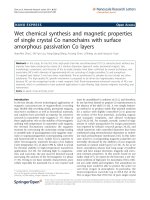Chemical speciation and extractability of zn, cu and cd in two contrasting biosolids amended clay soils
Bạn đang xem bản rút gọn của tài liệu. Xem và tải ngay bản đầy đủ của tài liệu tại đây (183.8 KB, 7 trang )
Chemical speciation and extractability of Zn, Cu and Cd in
two contrasting biosolids-amended clay soils
X.L. Qiao
a
, Y.M. Luo
a,
*
, P. Christie
b
, M.H. Wong
c
a
Laboratory of Material Cycling in the Pedosphere, Institute of Soil Science, Academia Sinica, P.O. Box 821, Nanjing 210008, China
b
Agricultural and Environmental Science Department, Queen’s University Belfast, Newforge Lane, Belfast BT9 5PX, UK
c
Department of Biology, Hong Kong Baptist University, Kowloon, Hong Kong
Abstract
An incubation experiment was conducted to study the chemical speciation and extractability of three heavy metals in
two contrasting biosolids-amended clay soils. One was a paddy soil of pH 7.8 and the other was a red soil of pH 4.7
collected from a fallow field. Anaerobically digested biosolids were mixed with each of the two soils at three rates: 20, 40
and 60 g kg
À1
soil (DM basis), and unamended controls were also prepared. The biosolids-amended and control soils
were incubated at 70% of water holding capacity at 25 °C for 50 days. Separate subsamples were extracted with three
single extractants and a three-step sequential extraction procedure representing acetic acid (HOAc)-soluble, reducible
and oxidisable fractions to investigate the extractability and speciation of the heavy metals. As would be expected, there
were good relationships between biosolids application rate and metal concentrations in the biosolids-amended soils.
The three heavy metals had different extractabilities and chemical speciation in the two biosolids-amended soils.
Ethylene diamine tetraacetic acid extracted more Cu, Zn and Cd than did the other two single extractants. The oxi-
disable fraction was the major fraction for Cu in both biosolids-amended soils and the HOAc-soluble and reducible
fractions accounted for most of the Zn. In contrast, Cd was present mainly in the reducible fraction. The results are
discussed in relation to the mobility and bioavailability of the metals in polluted soils.
Ó 2002 Elsevier Science Ltd. All rights reserved.
Keywords: Sewage sludge; Heavy metals; Sequential extraction; Single extraction; Speciation
1. Introduction
With continuing industrial development, urbaniza-
tion and a growing human population, large quantities
(>300 000 t dry weight per year) of biosolids are pro-
duced in China but the proportion of wastewater cur-
rently subjected to treatment processes is only slightly
above 4.5% (Zhou et al., 1999). A rapid increase in the
number of wastewater treatment plants with consequent
improvements in water quality can be expected over the
next several decades as government and the general
public become more aware of environmental issues. Bio-
solids contain plant nutrients in addition to potentially
toxic contaminants, and can therefore be used to recycle
nutrients during disposal. The major disposal options
currently available include application to agricultural
land, incineration, land reclamation, landfill, forestry
and application to ‘dedicated’ land (Matthews, 1992).
Dumping at sea has been prohibited in many countries
including China. Land filling and incineration are un-
popular because of the high cost and environmental
hazards involved. Land application has become more
popular because of the relatively low cost and the ben-
efits of recycling of nutrients and organic matter.
Despite the potential benefits, there is still much
concern about land application of biosolids, mainly due
to the potentially toxic elements present. Municipal
wastewater in China is usually mixed with industrial
wastewater before treatment and this results in much
Chemosphere 50 (2003) 823–829
www.elsevier.com/locate/chemosphere
*
Corresponding author. Tel.: +86-25-3228236; fax: +86-25-
3353590.
E-mail address: (Y.M. Luo).
0045-6535/03/$ - see front matter Ó 2002 Elsevier Science Ltd. All rights reserved.
PII: S 0 045-653 5(02 ) 0 0 226- 6
higher metal concentrations than in rural sludges. Zinc
and Cu often have the highest concentrations in the
biosolids. Cadmium is also of concern because of its
potentially harmful effects on humans and animals.
Despite the considerable international research effort on
the environmental effects of heavy metals in biosolids-
amended soils there remain some important questions.
For example, the forms of heavy metals that are most
available to plants and the mobility of metals in soils
will determine the effects on vegetation and the envi-
ronment. Total concentrations of heavy metals in soils
provide little or no indication of their specific bioavail-
ability, mobility and reactivity in biosolids-amended
soils (Sterritt and Lester, 1980; McBride, 1995). More-
over, the metals tend to be associated mainly with solid
soil components and exist in various physicochemical
forms (Lake et al., 1984). Improved knowledge of metal
speciation in biosolids-amended soils may be useful in
answering these questions. In the past two decades,
much effort has been expended in an attempting to
quantify metals held in different soil fractions in polluted
sites or soils treated with biosolids. Particular attention
has been paid to those fractions thought to be mobile
and bioavailable since these fractions can possibly leach
to pollute groundwater or enter food chains via plant
uptake. This paper presents an incubation study on the
extractability and chemical speciation of Zn, Cu and Cd
in two soils experimentally amended with anaerobically
digested biosolids. The data are discussed in relation to
potential plant uptake of metals and environmental risk
associated with increased levels of mobile heavy metals
in soils.
2. Materials and methods
2.1. Soil incubation
Samples of the two soils used were collected from the
plough layer (0–20 cm). One was a paddy soil of pH 7.8
(Gleyi-Stagnic Anthrosol) from Changshu Ecological
Experiment Station, Jiangsu Province and the other
was a ‘red soil’ of pH 4.7 (Agri-Udic Ferrosol) collected
from a fallow field at Yingtan Ecological Experiment
Station, Jiangxi Province. The anaerobically digested
sewage sludge (biosolids) were collected from a waste-
water treatment plant in Wuxi, Jiangsu Province. Se-
lected physical properties of the soils and biosolids are
shown in Table 1 and concentrations of major nutrients
and heavy metals are listed in Table 2. The fresh sludge
had a dry matter content of 24.5% and was air-dried to
57% DM before mixing with the soils.
The <2 mm air-dried soils were mixed with sludge
(also <2 mm) at four application rates: 0, 20, 40, 60
gkg
À1
soil (DM basis). Aliquots (equivalent to 500 g
DM) of amended and unamended soil were placed in
1890-cm
3
plastic boxes adjusted to 70% of water holding
capacity (WHC), covered with plastic film and incu-
bated at 25 °C for 50 days. The subsamples were ad-
justed to 70% WHC by adding water and weighing on a
weekly basis. There were four replicates of each treat-
ment. Subsamples were analyzed for extractable metals
by using three single extractants: ammonium acetate
(NH
4
OAc), acetic acid (HOAc) and ethylene diamine
tetraacetic acid (EDTA) and a three-step sequential ex-
traction procedure.
2.2. Single extraction
Aliquots of incubated moist soil equivalent to 5 g
(DM basis) were added to 25 ml of 1 mol l
À1
NH
4
OAc
(adjusted to pH 7.0 using ammonia or HOAc) in 50-ml
polyethylene centrifuge tubes and shaken on a New
Brunswick Scientific orbital shaker at room temperature
at 120 rpm for 16 h (overnight). The supernatants were
filtered through Whatman no. 40 paper. Further 5-g
aliquots were subjected to the same procedure but using
0.43 mol l
À1
HOAc and 0.05 mol l
À1
EDTA (adjusted to
pH 7.0 with ammonia) as the extractants, and the sus-
pensions in EDTA were shaken for only one hour before
filtration.
Table 1
Selected chemical and physical properties of the soils and biosolids
pH
(in water)
OM
(g kg
À1
)
CEC
(cmol kg
À1
)
Clay < 0:002
mm (%)
Taihu soil 7.8 15.8 21.6 34
Red soil 4.9 6.7 11.2 31
Biosolids 6.7 232.0 ND ND
N(gkg
À1
) P (g kg
À1
) K (g kg
À1
) Cu (mg kg
À1
) Zn (mg kg
À1
) Cd (mg kg
À1
)
Taihu soil 2.25 0.75 17.4 25 70 0.24
Red soil 0.59 0.57 10.2 30 151 0.05
Biosolids 21.6 20.4 7.6 404 2130 8.42
ND, not determined.
824 X.L. Qiao et al. / Chemosphere 50 (2003) 823–829
2.3. Sequential extraction
The sequential extraction procedure was described in
detail by Luo and Christie (1998a). Briefly, aliquots of
1 g (DM equivalent) of moist incubated soil were ex-
tracted using the following sequential extraction proce-
dure. Firstly, samples were shaken at room temperature
with 20 ml of 0.11 M CH
3
COOH for 16 h (overnight) in
50-ml polyethylene centrifuge tubes and centrifuged at
3000 rpm for 10 min. The supernatants were filtered
through Whatman no. 40 paper and then the weights of
the tubes (with their contents) were recorded. This ex-
tracted primarily the water-soluble and exchangeable
fraction of the metals that was weakly bound with or-
ganic matter and carbonates (‘HOAc-soluble’ fraction).
Secondly, the resulting residue was shaken at room
temperature with 20 ml of 0.10 M NH
2
OH Á HCl ad-
justed to pH 2.0 with high purity HNO
3
for 16 h
(overnight), centrifuged, filtered and tube weights re-
corded as above. This step extracted mainly iron and
manganese oxides bound forms (‘reducible’ fraction).
Thirdly, to the residue were added 10 ml of 30% H
2
O
2
to
avoid losses due to violent reaction. The mixture was
allowed to digest in the cold for 1 h. It was then taken to
dryness on a water bath heated to 85 °C. A second 10-ml
aliquot of H
2
O
2
was then added and taken to dryness on
Table 2
Extractable Cu, Zn and Cd in two biosolids-amended soils (Taihu paddy soil and red fallow soil) and unamended controls
Biosolids rate (g kg
À1
soil)
NH
4
OAc HOAc EDTA
Taihu Red Taihu Red Taihu Red
Copper (mg kg
À1
)
0 1.55 1.15 0.69 0.47 15.6 0.97
20 1.70 1.38 0.83 1.15 17.7 3.72
40 1.81 1.50 0.96 1.43 20.6 6.16
60 1.94 1.73 0.99 2.61 23.9 8.26
Significance
a
due to:
Soil type *** *** ***
Biosolids rate *** *** ***
Soil  rate * *** ***
Extractant ***
Soil  extractant ***
Rate Âextractant ***
Zinc (mg kg
À1
)
0 0.59 0.57 0.2 0.0
b
1.9 0.0
b
20 1.05 1.72 9.8 14.0 22.3 19.8
40 1.65 3.31 16.0 22.6 50.4 42.3
60 2.24 6.94 23.7 48.2 67.3 61.5
Significance
a
due to:
Soil type *** * ***
Biosolids rate *** *** ***
Soil  rate *** NS ***
Extractant ***
Soil  extractant ***
Rate Âextractant ***
Cadmium (lgkg
À1
)
0 7.4 5.7 12.3 4.4 139.0 14.4
20 15.5 21.9 16.3 14.7 171.3 45.0
40 22.2 33.1 13.9 21.9 198.0 81.0
60 27.6 53.9 20.9 38.9 222.5 89.9
Significance
a
due to:
Soil type *** NS ***
Biosolids rate *** *** ***
Soil  rate * *** ***
Extractant ***
Soil  extractant ***
Rate Âextractant ***
a
By analysis of variance of log
10
-transformed data; ***P < 0:001; **P < 0:01; *P < 0:05; NS, not significant.
b
Not detected (below detection limit).
X.L. Qiao et al. / Chemosphere 50 (2003) 823–829 825
a water bath at 85 °C with intermittent manual shaking.
After cooling, 25 ml of 1 M NH
4
OAc adjusted to pH 5.0
with HOAc were added to the dry residue to prevent the
readsorption of extracted metals on to the oxidized solid
residue. The mixture was extracted by shaking for 16 h
(overnight), followed by centrifugation and filtration as
before. This step extracted primarily organically bound
and sulfide metals (‘oxidisable’ fraction). The formula
F
i
¼fC
i
ðV
i
þ R
j
ÞÀC
iÀ1
R
j
g=W was used to calculated
the amount of metal (in mg) in each of the extracts as
described by Luo and Christie (1998a).
The soil water content was also measured to calculate
the metal concentrations in the dry matter. All soil ex-
tracts were analyzed for Cu and Zn by flame atomic
absorption spectrophotometry and for Cd by graphite
furnace atomic absorption spectrophotometry using a
Hitachi Z-8200 atomic absorption spectrophotometer.
2.4. Statistical analysis
Data were subjected to analysis of variance in a fac-
torial design of two soils and four application rates of
biosolids (including unamended controls). Linear and
quadratic contrasts were calculated for the four appli-
cation rates of biosolids and for the interaction between
soil type and biosolids application rate to compare the
trends in extractable metals in the two soils with
changing biosolids application rate. All of the data for
the single extractions were also combined to compare
the three extractants and the three metals. Most vari-
ables were not normally distributed and were log
10
-
transformed prior to statistical analysis but the mean
values presented are non-transformed.
3. Results
3.1. Single extraction
NH
4
OAc and EDTA extracted more Cu, Zn and
Cd from Taihu paddy soil than from red fallow soil,
but differences between HOAc-extractable metals were
smaller (Table 2). Although HOAc-extractable Cu was
significantly lower in Taihu paddy soil on average
(P < 0:001), the differences were numerically small.
HOAc-extractable Zn was also higher (P < 0:05) in
Taihu paddy soil, but Cd showed no difference between
the two soils. The magnitude of the difference between
the two soils in NH
4
OAc- and EDTA–Cu and Zn be-
came more pronounced with increasing application rate
of biosolids. The interaction between soil type and bi-
osolids application rate was always significant (except
for HOAc–Zn) because the rate of increase in extract-
able metal with increasing biosolids rate was always
more pronounced in red fallow soil than Taihu paddy
soil. Linear contrasts for the soil  biosolids rate (not
presented) were always significant (P < 0:001 or P <
0:01) except for HOAc–Zn, indicating that soil extract-
able metals increased linearly with increasing biosolids
rate and increased more sharply in the red fallow soil
than in Taihu paddy soil. Quadratic contrasts for Cu
and Zn were not significant (except for HOAc–Cd at
P < 0:05), but were significant for EDTA–Cu (P < 0:05)
and EDTA–Zn and Cd (both P < 0:001). Overall, the
amounts of metals extracted by the three extractants
followed the sequence EDTA > NH
4
OAc > HOAc for
Cu and Cd, and EDTA > HOAc > NH
4
OAc for Zn
(Table 2). When the mean extractable metal fractions in
the two soils were compared with biosolids application
rate by linear regression and correlation, the correlation
coefficients were always significant (at least P < 0:01)
except for HOAc–Zn in Taihu paddy soil which still had
a large correlation coefficient (r) of 0.861 (data not
shown).
3.2. Sequential extraction
The metal fractions in the sequential extraction
scheme are shown in Fig. 1. Oxidisable Cu was the
largest extractable fraction in unamended Taihu paddy
soil, while HOAc-extractable Cu and oxidisable Cu to-
gether comprised most of the extractable Cu in the red
fallow soil. Biosolids application increased all three ex-
tractable Cu fractions in the red soil, while the distri-
bution of the fractions in Taihu soil was similar in
unamended soil and at all three biosolids application
rates. Biosolids produced a large increase in the reduc-
ible Cu fraction in the red soil which became more
pronounced with increasing biosolids application rate.
Mean metal concentrations in the three sequential
fractions were compared with biosolids application rate
by linear regression and correlation and all of the cor-
relation coefficients (except HOAc–Cu in Taihu paddy
soil) were significant (data not shown).
4. Discussion
4.1. Single extraction
In Taihu paddy soil the extractability sequence for
Cu was EDTA > NH
4
OAc > HOAc, while in red fal-
low soil, it was EDTA > HOAc > NH
4
OAc. The dif-
ference is likely to be related to soil properties, especially
organic matter content and pH. The greater amounts of
Zn extracted by HOAc in the biosolids-amended soils
were compared with those extracted by NH
4
OAc may
be attributable to the sensitivity of Zn to soil acidity, the
factor also implicated by the difference in the extraction
efficiency of HOAc in the two soils. Extractable Cd
showed similar trends to Cu in both soils irrespective of
biosolids amendment.
826 X.L. Qiao et al. / Chemosphere 50 (2003) 823–829
Although there has been much debate about which
part of metals in soils is the ‘bioavailable’ fraction, plant
uptake in biosolids-amended soils has often been cor-
related with some extractable fraction of the soil metal.
The aim has been to use a relatively quick and simple
chemical extraction to describe the mobility and bio-
availability of heavy metals. A wide range of extractants
have been employed including EDTA, DTPA, NH
4
NO
3
and HOAc with varying success, but there is no fully
satisfactory extractant for all soil–plant systems because
of varying properties of different soil types and plant
species. Considerable efforts have been made to measure
accurately extractable trace metal concentrations in soil
samples (Quevauviller, 1996, 1998). The single extract-
ants used in our experiment were employed by Ure et al.
(1993) to determine the extractable concentrations of
Cd, Cr, Cu, Ni, Pb and Zn in sewage sludge-amended
soils. As in our study, metal extractability was found to
differ among the three extractants. NH
4
OAc is a mild
extractant that can extract only the easily exchangeable
metals, HOAc can dissolve part of the metals from soil
solids because of its weak acidity and EDTA is the
Fig. 1. Speciation of Cu, Zn and Cd in biosolids-amended: (a) Taihu paddy soil and (b) red fallow soil.
X.L. Qiao et al. / Chemosphere 50 (2003) 823–829 827
strongest of the three extractants. The complex con-
stants of EDTA with most metals are fairly large, and a
rather large percentage of total metals can be extracted.
4.2. Sequential extraction
Biosolids amendment led to a dramatic increase in
reducible Cu in red soil which became more pronounced
with increasing biosolids application rate. Differences in
the distribution of metal fractions between the two soils
was likely to be affected by soil properties, especially soil
organic matter content and pH. Taihu paddy soil has a
much higher pH and organic matter content than red
fallow soil. There has been a rather long fertilization
period before the maturation of red soil, which has re-
sulted in a much higher iron:alumina ratio in red soil
than in Taihu paddy soil. The extraneous metals may be
readily absorbed or occluded by iron-alumina oxides
and iron-manganese concretion in the acid conditions of
the red soil.
Compared with Cu, the oxidisable fraction of Zn was
much smaller and there was much more HOAc-soluble
Zn in both soils (Fig. 1). This may be explained by
differences in chemical characteristics between Cu and
Zn. Copper can be preferentially combined with organic
matter (Luo and Christie, 1998b), while Zn appears to
be more sensitive to soil acidity. The reducible fraction
of Zn accounted for the largest proportion of extractable
Zn in Taihu paddy soil after biosolids application, while
HOAc–Zn was the dominant fraction in biosolids-
amended red fallow soil, and this may have been due in
part to differences in soil pH.
The reducible fraction of Cd was predominant in
Taihu paddy soil irrespective of biosolids amendment,
but HOAc–Cd and the reducible fraction together ac-
counted for a large proportion of Cd in the red fallow
soil because of the lower pH. There were some similar-
ities between the distributions of Zn and Cd, with small
oxidisable fractions and large reducible fractions.
However, Cd may be more readily fixed by iron-alu-
minium oxides and iron-manganese concretions than Zn
or Cu.
Single chemical extraction of sewage sludge-amended
soils is usually used for assessment of bioavaibility of
sludge-borne heavy metals. It is more appropriate for
the estimation of short and medium term metal risks
(Tack and Verloo, 1996). However, the use of single
extraction in the study of the distribution of heavy
metals in biosolids-amended presents some problems. It
is almost impossible to study metal speciation using only
one extractant. It is also very difficult to estimate the
environmental effects in the long term using single ex-
traction techniques. Soil components and properties
vary greatly in different soils, and these can have a very
important influence on the mobility and bioavailability
of heavy metals. Sequential extraction can provide more
information about the chemical speciation of metals.
5. Conclusions
Most of the differences in the sizes of the single ex-
traction and sequential extraction fractions of the three
metals in the two soils can be explained by differences in
soil organic matter content and pH and the influence of
these soil properties on the behaviour of the metals in
the soil. The fraction of metal available to plants may
not be the same as the fraction at risk of loss by leaching
to the environment. Further studies are therefore re-
quired to determine plant uptake of the metals in the
two biosolids-amended soils and to study leaching of the
metals from the soils in the presence and absence of
plant uptake.
Acknowledgements
The authors are grateful for grant-aided support
from the National Science Foundation of China (no.
49831070 and no. 40125005) and from the Major State
Basic Research and Development Program of the Peo-
ple’s Republic of China (G1999011807). This study was
also supported by the Laboratory of Material Cycling in
Pedosphere (LMCP) and the Joint Open Laboratory of
Soil and Environment (JOLSE), both at the Institute of
Soil Science, Chinese Academy of Sciences.
References
Lake, D.L., Kirk, P.W.W., Lester, J.N., 1984. Fractionation,
characterization, and speciation of heavy metals in sewage
sludge and sludge-amended soils: A review. J. Environ.
Qual. 13 (2), 175–183.
Luo, Y.M., Christie, P., 1998a. Choice of extraction technique
for soil reducible trace metals determines the subsequent
oxidisable metal fraction in sequential extraction schemes.
Int. J. Environ. Anal. Chem. 72 (1), 59–75.
Luo, Y.M., Christe, P., 1998b. Bioavailability of copper and
zinc in soils treated with alkaline stabilized sewage sludges.
J. Environ. Qual. 27 (2), 335–342.
McBride, M.B., 1995. Toxic metal accumulation from agricul-
ture use of sludge: Are USEPA regulations protective?
J. Environ. Qual. 24 (1), 5–18.
Matthews, P.J., 1992. Sewage sludge disposal in the UK: A new
challenge for the next twenty years. J. Inst. Water Environ.
Manage. 6, 551–559.
Quevauviller, P., 1996. Certified reference materials for the
quality control of total and extractable trace element
determinations in soils and sludges. Commun. Soil Sci.
Plant Anal. 27 (3–4), 403–418.
Quevauviller, P., 1998. Operationally defined extraction proce-
dures for soil and sediment analysis. I. Standardization.
Trends Anal. Chem. 17, 289–298.
828 X.L. Qiao et al. / Chemosphere 50 (2003) 823–829
Sterritt, R.M., Lester, J.N., 1980. The value of sewage sludge to
agriculture and effects of the agriculture use of sludges
contaminated with toxic elements: A review. Sci. Total
Environ. 16 (1), 55–90.
Tack, F.M., Verloo, M.G., 1996. Impact of single reagent
extraction using NH
4
OAc–EDTA on the solid phase
distribution of metals in a contaminated dredged sediment.
Sci. Total Environ. 32 (1), 29–36.
Ure, A.M., Quevauviller, P., Muntau, H., Griepink, B., 1993.
Speciation of heavy metals in soils and sediments: An
account of the improvement and harmonization of extrac-
tion techniques undertaken under the auspices of the BCR
of the CEC. Int. J. Environ. Anal. Chem. 51, 135–151.
Zhou, L.X., Hu, A.T., Ge, N.F., Hu, Z.M., 1999. Research on
sewage sludge land application. Acta Ecologica Sinica 19
(2), 185–193 (in Chinese).
X.L. Qiao et al. / Chemosphere 50 (2003) 823–829 829
